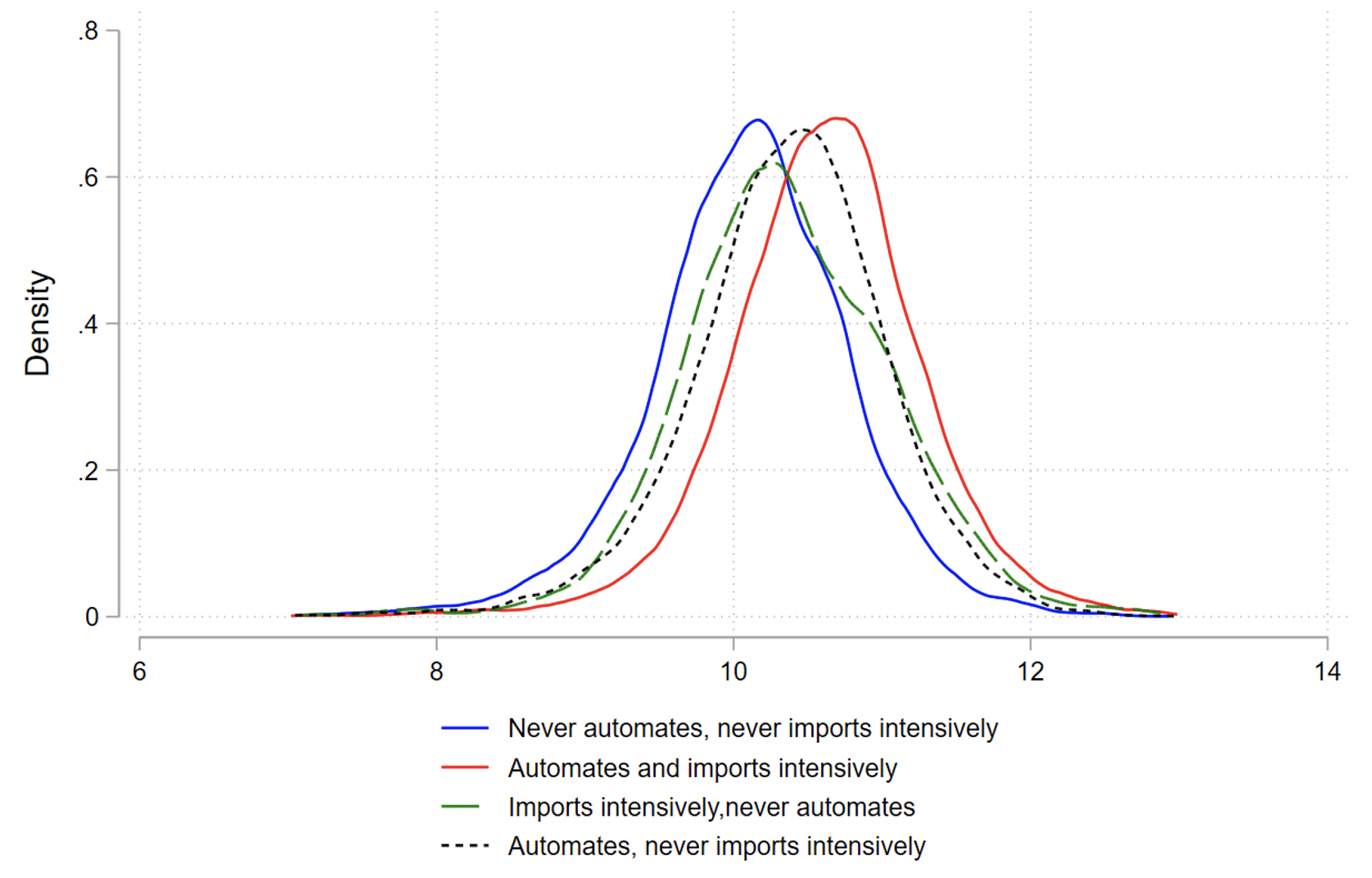Some of the biggest development gains in history have been associated with industrialisation. The path of manufacturing-led development has often been facilitated by offshoring and the integration of developing countries into global supply chains. Recent advances in robotics and machine intelligence have spurred a growing discussion about the prospect of automation substituting for labour in lower-income countries, reducing offshoring and the future scope for manufacturing-led development in parts of the world that have yet to industrialise.
This question has substantial implications, yet we know remarkably little about how advances in technologies like industrial robots over the past three decades have impacted trade and global supply chains. A number of researchers have recently started to fill this gap by studying how the deployment of industrial robots at the industry level has affected trade flows and FDI, reaching mixed conclusions. While Artuc et al. (2018) and Hallward-Driemeier and Nayyar (2019) both show positive impacts of robot intensity in high-income countries on imports sourced from, or FDI growth to, lower-income countries, other papers that focus only on trade between the US and Mexico, such as Artuc et al. (2019) and Faber (2018), find negative effects of automation.
To delve into this relationship in more detail, it is important to study how firms make decisions about their supply chains and technology adoption. To date there is, in fact, very little empirical evidence about why, and when, firms automate and how it affects firm outcomes, domestic or international. One of the reasons for this lack of understanding has been the limited availability of data for researchers to study firm level decisions about technology adoption.
In our recent paper (Stapleton and Webb 2020), we use a rare dataset of Spanish manufacturing firms that provides both rich information on firm technology use and details on trade and multinational activity between 1990 and 2016 to study how automation in Spanish firms affected imports and multinational activity involving lower-income countries.
We begin by documenting that only a small subset of firms in our dataset adopt three distinct automation technologies: robots, computer numerically controlled (CNC) machines, and flexible manufacturing systems (FMS); but these firms account for the majority of employment, production, and trade. For example, in 2014, 33% of the firms in our sample used robots, but these firms accounted for 64% of manufacturing employment, 66% of value added, and 72% of exports. Firms that automate are on average around twice as large, have around 60% higher TFP, export and import nearly four times more and are around 10% more likely to be a multinational than other firms in the same narrowly defined industry, region, and year.
Firms that adopt these technologies already import more and have more affiliates in all regions, including lower-income countries, but source a lower share of their imports from lower-income countries prior to adoption. This gap is then wider, in any time period, between firms that have already automated and those that haven’t. Figure 1 displays these ‘premia’ associated with being a robot user in the present or future.
Figure 1 Robot adoption ‘premia’ for current and future robot adopters
Notes: This figure displays the coefficients or ‘premia’ obtained from cross-section regressions of a dummy variable for if a firm is a current or future robot user on the listed outcomes, controlling for industry and region fixed effects.
Contrary to the typical assumption that automation might cause reshoring, we find that firms in our sample were, in fact, more likely to have started automating, using either robots, FMS, or CNC machines, before starting to import intensively from, or open affiliates in, lower income countries. Firms that either automate, or offshore to lower-income countries, are more productive than firms that don’t do either, but the most productive firms in the sample both automate and offshore. Figure 2 displays the labour productivity distribution of firms by whether they automate using one of the three technologies and whether they import intensively from lower-income countries.1
Figure 2 Labour productivity distribution by status of automation and importing from lower-income countries
Notes: This figure displays the distribution of the log of value added per worker for firms by whether they automate using either robots, CNC machines or FMS and whether they import intensively (defined as being in the top 20% of the sample in terms of the ratio of imports to output) from lower-income countries.
To evaluate the causal impact of automation on trade and multinational activity, we take advantage of robotics inventions that made it technically feasible, over time, to automate some tasks and not others. We follow Webb (2019) and use the text from patent titles to measure the overlap between the tasks that robotics inventions are designed to conduct, and the tasks conducted by different occupations.
Our motivation is that many technological developments in robotics stem from research conducted at universities and breakthroughs are often driven by advances in complementary technologies in other fields. These supply-side advances in the technological capabilities of robots are plausibly exogenous to the Spanish firms that are subsequently faced with the commercial availability of some specific types of robots.
Using this instrument, we show that robot adoption in Spain caused firms to increase their value of imports from, and the number of affiliates in, lower-income countries. Robot adoption also had a positive impact on the probability of firms starting to import from, or open affiliates in, lower-income countries. We find that robot adoption caused firms to substantially expand production and increase both labour productivity and TFP.
The sequencing of robot adoption and offshoring has important consequences for the impact of robot adoption. When we focus on firms that were importing intensively from lower-income countries before they started to use robots, we find that robot adoption had no effect on the value of imports from lower-income countries but decreased the share of imports sourced from lower-income countries. By contrast, for firms that started using robots before importing intensively from lower-income countries, robot adoption had a positive impact on the probability of them starting to import from lower-income countries and the value of their imports. The effect for the latter group dominates, such that for the full sample the net impact of robot adoption on imports from lower-income countries is positive.
We use a simple framework incorporating a task-based approach similar to that in Acemoglu and Restrepo (2018) into a model with Melitz (2003) style firm heterogeneity and fixed costs. This setup can provide an explanation for some of these findings. Firms have the option to conduct tasks at home, offshore them, or automate them. Both technology adoption and offshoring involve paying an up-front fixed cost but offer a marginal cost reduction. This implies that for firms that were already offshoring, automation displaces tasks from offshore labour. For firms that were not offshoring, automation displaces tasks from home labour. For both, automation reduces production costs; generating a productivity effect and inducing them to expand and demand more labour at home or abroad for non-automatable tasks.
Our results suggest that, for Spanish manufacturing firms, this productivity effect of automation may have outweighed the displacement effect for offshoring. For the subset of firms that were not already offshoring, the productivity effect of automation may have even enabled them to expand and afford the fixed cost of setting up offshoring relationships.
Taken together, these results suggest that fears about the consequences of automation for reshoring have over-simplified what is, in fact, a complex relationship and there are reasons why automation could actually increase trade with lower-income countries.
References
Acemoglu, D and P Restrepo (2018), “The Race between Man and Machine: Implications of Technology for Growth, Factor Shares, and Employment,” American Economic Review 108(6): 1488–1542.
Artuc, E, L Christiaensen and H J Winkler, “Does Automation in Rich Countries Hurt Developing Ones? : Evidence from the U.S. and Mexico”, Technical Report 8741, World Bank, February.
Artuc, E, P S R Bastos and B Rijkers (2018), Robots, Tasks and Trade, Technical Report 8674, The World Bank, December.
Faber, M (2018), “Robots and reshoring: Evidence from Mexican local labor markets”, Technical Report 2018/27, Faculty of Business and Economics - University of Basel, Working Paper, October.
Hallward-Driemeier, M and G Nayyar (2019), “Have Robots Grounded the Flying Geese? Evidence from Greenfield FDI in Manufacturing”, SSRN Journal.
Melitz, M J (2003), “The Impact of Trade on Intra-Industry Reallocations and Aggregate Industry Productivity”, Econometrica 71 (6): 1695–1725.
Stapleton, K and M Webb (2020), “Automation, trade and multinational activity: Micro evidence from Spain”, SSRN Journal.
Webb, M (2019), “The Impact of Artificial Intelligence on the Labor Market”, SSRN Journal.
Endnotes
1 Here we define importing intensively as being in the top 20% of the sample in terms of the ratio of imports from lower-income countries to output.






